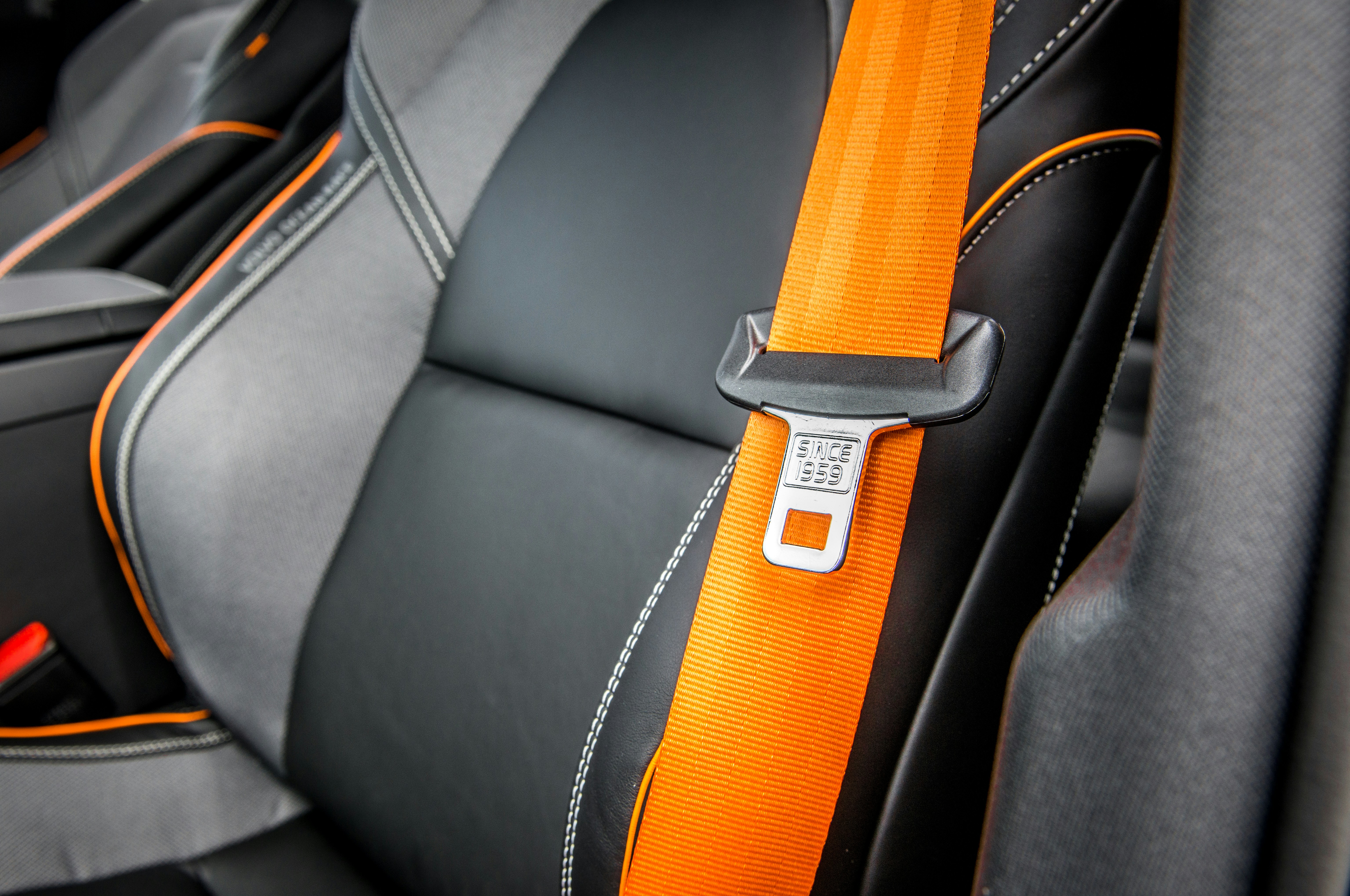You probably wear one every time you’re in a car, but how much do you really know about seat belts?
The very first safety belt was invented in the 1800s, but seat belts weren’t a required accessory in cars until the late 1960s, and laws mandating seat belt usage didn't arrive for another 20 years. And they weren’t exactly popular. In fact, regulations that required the automotive industry to provide seat belts were initially fought by the Reagan administration!
Today, however, seat belt usage in the United States is around 92% and seatbelts are believed to save around 15,000 American lives per year.
In this article, we’ll take a look at the humble seat belt: how seat belts work, seat belt history, and the safety statistics for seat belt usage today.
(And yes, according to AP Style, it’s “seat belt” – two words!)

Your Complete Guide to Seat Belts
Seat belts are everywhere. But why do we have to wear them, how do they work, and where did they come from? Read on to learn more about this life-saving device.
Seat Belts: Essential Facts
Let’s start with the basics. Seat belts are usually made up of:
Anchors, the places where the seat belt is securely attached to the car
Webbing, the actual fabric belt itself (or belts), usually made from a strong and elastic tightly woven polyester
Buckle(s), the socket and tongue system that secure the webbing around the seat occupant
Retractor(s), the mechanism that controls the amount of webbing in use and its fit, sometimes equipped with a pre-tensioner that reacts to sudden pulls and locks the belt in place for safety
Generally, seat belts are classed by “points” – meaning anchors, the places where the belt is attached to the vehicle.
You may have seen a few different kinds of seat belts around. The seatbelts on planes are typically two-point lap belts, variations of which are also sometimes still seen in the rear seats of older vehicle models. These seat belts are attached to the vehicle at two points, one on either side of your hips, thus the name.
The most ubiquitous seatbelts in the United States, however, are what are called three point seat belts – think car seat belts with both a lap and shoulder (sash) strap, meeting together at one point with a buckle. These three-point belts – first invented by engineer Nils Bohlin for Volvo in the 1950s – are legally mandated by the U.S., U.K., and Canada, among others, for their improved safety.
That said, seat belt types don’t end at three points! If you’ve ever watched NASCAR or fastened a child’s car seat, you might be familiar with 4, 5, and 6-point belts, and some aerial artists even use a 7-point system to make sure they’re protected from falls.
How Seat Belts Work
Thinking back to physics class, you might remember that an object in motion tends to stay in motion.
In an accident, if your car hits something and suddenly stops, your body – if not attached to the car – will continue moving forward. Many of the worst injuries and fatalities on the road come when a person is ejected from the vehicle or hits the dashboard or vehicle ceiling.
While seat belts might not be perfect at preventing all injuries, they significantly reduce the risk of serious injury or death by holding a person in place.
Interestingly, Nils Bohlin, the Volvo engineer who invented the 3 point seat belt, had previously been employed in aviation as an engineer working on systems for safely ejecting from fighter jets. He applied many of the same principles of motion when he was charged with making vehicles safer.
You may be overpaying on your auto loan
Car dealerships mark up their prices, leaving you paying more than you need to be. It’s easy to find out how much money you could save with a better rate and lower car payment through Auto Approve. All it takes is a few clicks – no commitment required.
Better safe than sorry, right?
Get a free quote to see how much you could save.

Seat Belt History
The First Seat Belts
As mentioned above, the very first safety belt was arguably invented in the early 1800s. Sir George Cayley, an English aerial pioneer who designed the first successful glider to carry a human being, included a rudimentary harness on the glider.
The line, however, from that harness to today’s ubiquitous seat belts is not a straight one. While Cayley may have been the first to think strapping in made safety sense as new vehicles developed, his idea didn’t catch on like wildfire. Seat belts don’t appear again until, separately, a New Yorker named Edward J. Claghorn patented an idea for a harness for taxi passengers in 1885, and it wasn’t until the 1920s that similar devices came into the public consciousness when race car pioneer Barney Oldfield commissioned a parachute manufacturer to create a system to strap him into his vehicle for the Indy 500.
Even then, seatbelts remained deeply unpopular. According to AAA, there was a belief at the time that it was safer to be ejected from the vehicle, and car manufacturers worried that too many safety features would imply that their vehicles weren’t safe to drive.
For those reasons, it wasn’t until Nils Bohlin invented the three-point belt – much as we know it today, with one continuous belt to protect both the upper and lower body, attached by a single buckle – that seat belts really took off.
Seat Belts As We Know Them
Bohlin’s three-point belts improved vehicle safety greatly and started to become commonplace in some parts of the world. This expansion was greatly aided by the fact that Bohlin and Volvo decided to give the design for the seat belt away for free, making it available to all vehicle manufacturers in the late 1950s.
In 1961, Wisconsin became the first U.S. state to require seat belts be installed in the front seats of cars, and in 1968, some sort of belt in the front seat was a federal requirement. But that’s not the end of the story, by far!
It might be strange now to think of, but as recently as the 1970s and ‘80s, seat belts were controversial and faced legal challenges in the United States.
The Reagan administration tried to turn the tide on regulations requiring manufacturers to include seat belts, revoking the existing regulations. In an unexpected twist, it was insurers who sued to get the seat belt requirements reinstated in the interest of passenger safety. They won their case in the Supreme Court, and seat belts became a required part of each new vehicle produced or sold in the United States.
From there, states began rolling out different regulations requiring drivers and passengers to wear their seat belts, starting with New York mandating those in the front seat of a vehicle wear a seat belt or face a fine. These laws were seen by some as government overreach and an infringement on personal freedoms, but as study after study showed that belts reduced the risk of fatalities, head injury, and other serious injuries, public opinion came around.
Today, every state except New Hampshire has some sort of law on the books requiring seat belt usage, though details, enforcement, and possible consequences vary.

Seat Belt Safety Statistics
For many people, the biggest question is. Do seat belts actually make you safer? And the answer is a resounding yes.
According to data from the National Highway Traffic Safety Administration, part of the US Department of Transportation, in 2017 alone, seat belts saved 14,955 lives and could have saved 2,549 more.
Here are a few more key facts from the NHTSA:
Being ejected from a car in a crash is almost always fatal.
If you’re not buckled up, air bags not only won’t be enough to protect you, but can do serious injury. Air bags are designed to be used in conjunction with seat belts – not instead of them.
Improper seat belt use – using only one part of the belt or placing it under your arm – is less effective and can be dangerous.
Most importantly, correctly wearing your three-point seat belt when in a passenger car reduces your risk of fatal injury by 45% and of moderate or critical injury by 50%. These numbers are even higher for light truck drivers and passengers (60% and 65%, respectively).
In Short, Seat Belts Make Riding In A Car Safer
Now you know so much more about the what, how, and why of seat belt safety! Make sure you buckle up on your next ride, whether it’s a quick trip to the grocery store or an epic road trip, and encourage your loved ones to do the same.
Put more money in your pocket for the things that matter
Find out how much you can save by refinancing your vehicle with Auto Approve. Getting a quote is easy. We’ll help you find the best deal for you, then handle the paperwork for you.